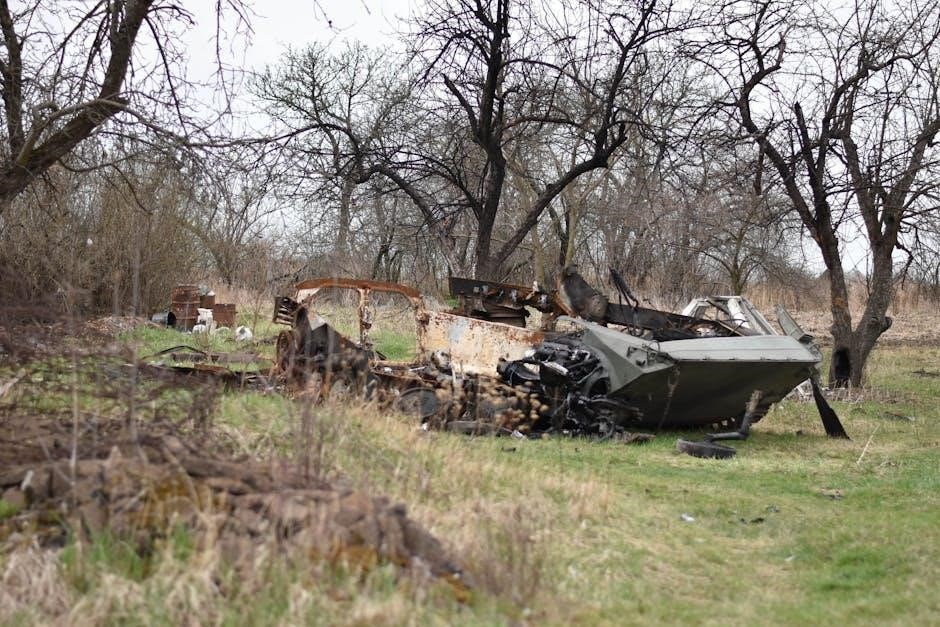Cold War cartoons serve as a visual medium for political expression, reflecting tensions and propaganda of the era. They provide insights into public sentiment and government agendas, offering a unique lens to analyze historical conflicts and ideological battles between the U.S. and the Soviet Union. By examining these cartoons, historians and students can uncover the symbolism, stereotypes, and perspectives that shaped Cold War discourse, making them a valuable tool for understanding this pivotal period in global history.
Significance of Political Cartoons in Historical Analysis
Political cartoons are vital for understanding historical contexts, as they capture the essence of public sentiment and political agendas. During the Cold War, these visual commentaries simplified complex ideologies, making them accessible to a broad audience. They serve as primary sources, reflecting the fears, tensions, and propagandistic narratives of the time. By analyzing these cartoons, historians can uncover underlying themes, such as ideological battles and geopolitical strategies. Their use of symbolism and satire provides insights into the societal mindset, offering a unique perspective on historical events. Furthermore, studying these cartoons fosters critical thinking and media literacy, enabling deeper engagement with the Cold War’s impact on international relations and cultural dynamics.
Overview of the Cold War and Its Representation in Cartoons

The Cold War, spanning from the late 1940s to the early 1990s, was a period of intense rivalry between the United States and the Soviet Union. Cartoons from this era vividly depicted this ideological struggle, often using exaggerated imagery and metaphors. Themes such as the arms race, space exploration, and political propaganda were common. Cartoonists employed symbols like eagles for American strength and bears for Soviet might, reinforcing national identities. These visual narratives not only reflected the fears of nuclear war but also the competition for global influence. By examining these cartoons, one gains a visual understanding of the Cold War’s complexities and its profound impact on international relations and popular culture.

Historical Context of the Cold War
The Cold War emerged post-WWII, driven by ideological tensions between the U.S; and Soviet Union, shaping global politics, alliances, and cultural expressions, including cartoons, for decades.
Key Events and Ideological Conflicts
The Cold War was marked by pivotal events that fueled ideological tensions, such as the Cuban Missile Crisis, the Berlin Wall construction, and the Space Race. These events symbolized the clash between capitalism and communism, with each side vying for global influence. Political cartoons from this era often depicted these conflicts, using symbolism to convey the fears and propaganda of the time. For instance, cartoons highlighting the arms race or nuclear threats reflected the era’s anxieties. These visuals served as powerful tools for shaping public opinion, emphasizing the ideological divide between the U.S. and the Soviet Union. By analyzing these cartoons, historians can gain insights into how key events were perceived and misrepresented during the Cold War.
The Role of Propaganda in Shaping Public Opinion
Propaganda played a pivotal role in shaping public opinion during the Cold War, with political cartoons serving as a powerful medium. Both the U.S. and the Soviet Union utilized cartoons to disseminate ideologies, often exaggerating the enemy’s threats while glorifying their own systems. American cartoons frequently depicted communism as oppressive, while Soviet cartoons portrayed capitalism as exploitative. These visuals reinforced fear and loyalty, influencing how citizens viewed global conflicts and domestic policies. By analyzing these cartoons, it becomes clear how propaganda simplified complex issues, creating stark divisions between “good” and “evil.” This manipulation of perception remains a critical aspect of understanding Cold War dynamics and their enduring impact on international relations.

Cartoon Themes and Symbolism
Cold War cartoons often featured themes of ideological battles, nuclear threats, and superpower rivalry, using symbols like Uncle Sam, the Soviet bear, and missiles to convey political messages.
Anti-Communist Cartoons in the United States
Anti-communist cartoons in the U;S. were powerful tools for shaping public opinion during the Cold War. These cartoons often depicted the Soviet Union and communism as oppressive, threatening forces, using exaggerated imagery to stir fear and patriotism. Common themes included the portrayal of Soviet leaders as menacing figures, the hammer and sickle symbol as a sign of tyranny, and the spread of communism as a global menace. Cartoonists frequently contrasted American values of freedom and democracy with the perceived authoritarianism of the Soviet regime. Such visuals reinforced the ideological divide, influencing U.S. foreign policy and domestic attitudes. These cartoons remain significant for understanding how visual propaganda contributed to Cold War tensions and the broader cultural narrative of the era.
Pro-Communist Cartoons in the Soviet Union
Pro-communist cartoons in the Soviet Union served as propaganda tools to promote socialist ideals and critique capitalist societies. These cartoons often depicted the USSR as a beacon of equality, progress, and peace, contrasting it with the perceived greed and instability of Western nations. Common themes included the portrayal of Soviet leaders as wise and benevolent, the glorification of industrial and agricultural achievements, and the promotion of unity among socialist states. Symbols like the hammer and sickle were frequently used to represent the working class and collective strength. These cartoons also aimed to counter Western anti-communist narratives, reinforcing the Soviet worldview and fostering loyalty among its citizens. They provide valuable insights into the ideological battles of the Cold War era.
Cartoons Depicting the Arms Race and Nuclear Threat
Cold War cartoons frequently depicted the arms race and nuclear threat, reflecting the era’s heightened tensions and fear of annihilation. These cartoons often used exaggerated imagery, such as giant missiles, mushroom clouds, and doomsday clocks, to convey the gravity of the situation. In the U.S., cartoons sometimes portrayed the Soviet Union as an aggressive force, while Soviet cartoons depicted the U.S. as a reckless provocateur. Both sides used these visuals to shape public opinion, emphasizing the need for military preparedness and ideological vigilance. The nuclear threat became a recurring motif, symbolizing the fragile balance of power and the existential risks of the Cold War. These cartoons not only mirrored the fears of the time but also simplified complex geopolitical tensions for mass audiences.
Analyzing Cold War Cartoons
Analyzing Cold War cartoons involves examining historical context, symbols, and stereotypes to uncover underlying political messages and ideologies. This process reveals how cartoons reflected and shaped public perceptions during the era.
Identifying Symbols and Stereotypes
Cold War cartoons frequently employed symbols and stereotypes to convey political messages. In U.S. cartoons, symbols like Uncle Sam, the American eagle, and the Statue of Liberty represented democracy, while the Soviet Union was often depicted with hammer-and-sickle imagery or as menacing figures. Stereotypes like the “Red Menace” or “evil communist” were common, reinforcing ideological divides. Conversely, Soviet cartoons portrayed the U.S. as imperialistic, using symbols like dollar signs or military imagery. By analyzing these visual elements, one can uncover the underlying propaganda and biases of the era. Identifying such symbols and stereotypes is crucial for understanding the cartoons’ historical context and the perspectives they aimed to shape.
Understanding the Artist’s Perspective
Analyzing Cold War cartoons requires understanding the artist’s perspective, as their work often reflected personal or national biases. Cartoonists from the U.S. and Soviet Union used exaggerated imagery to express their views on political events and ideologies. For instance, American cartoonists frequently depicted Soviet leaders as aggressive or manipulative, while their Soviet counterparts portrayed American politicians as imperialistic. By examining the artist’s background and the historical context in which the cartoon was created, one can gain insights into the motivations and intended messages. This perspective reveals how cartoonists acted as agents of propaganda, shaping public opinion through visual narratives that aligned with their respective nations’ agendas during the Cold War era.
Techniques Used to Convey Political Messages
Cold War cartoons employed various techniques to convey political messages effectively. Symbolism was widely used, with icons like Uncle Sam, the American eagle, and the Soviet bear representing nations. Exaggeration and caricature emphasized traits, making ideologies appear starkly contrasting. Labeling objects or figures provided clarity, ensuring messages were direct. Contrasting imagery highlighted moral differences, such as freedom vs. oppression. Artists also used metaphors, like chess games or arm wrestling, to depict superpower struggles. These techniques, combined with bold visuals, made complex political issues accessible to the masses, shaping public opinion and reinforcing propaganda agendas during the Cold War era.
Key Cartoonists and Their Works
Prominent cartoonists like Clifford Berryman and his son Jim created influential works reflecting Cold War tensions, using bold imagery to depict superpower struggles and ideological clashes.
Influential Cartoonists of the Cold War Era
During the Cold War, cartoonists played a pivotal role in shaping public opinion through their art. Influential figures like Herbert Block (“Herblock”) in the U.S. and Boris Efimov in the Soviet Union used their craft to convey strong political messages. Block’s cartoons, often published in The Washington Post, criticized McCarthyism and highlighted the dangers of nuclear warfare. Efimov, a prominent Soviet cartoonist, depicted capitalist societies unfavorably, aligning with communist ideology. Their work not only reflected the ideological divide but also influenced the perception of global events. These cartoonists became iconic voices of their respective nations, leaving a lasting impact on historical interpretation and cultural discourse during the Cold War era.
Iconic Cartoons and Their Historical Significance
Iconic Cold War cartoons often captured the essence of geopolitical tensions and ideological clashes. One notable example is Clifford Berryman’s depiction of Joseph Stalin as a menacing figure, symbolizing Soviet influence in Greece. Another iconic cartoon from the Cuban Missile Crisis portrayed the world teetering on the brink of nuclear war, emphasizing the high stakes of superpower rivalry. These cartoons were not just humorous illustrations; they were powerful tools for political commentary, reflecting public fears and government agendas. By simplifying complex issues into visual narratives, they provided accessible insights into the era’s anxieties. Their historical significance lies in their ability to encapsulate the spirit of the Cold War, offering a visual record of its key events and ideological struggles.
Cold War cartoons offer a unique perspective on historical tensions and propaganda. For deeper understanding, explore resources like “Cartoons and Comics on the Cold War” from loc.gov and educational materials analyzing political cartoons from the Cuban Missile Crisis. These sources provide insights into key events and ideological conflicts, making them invaluable for further study and analysis.

Summarizing the Role of Cartoons in Cold War Analysis
Cold War cartoons played a pivotal role in shaping public perception and understanding of the era’s geopolitical tensions. They served as visual propaganda tools, highlighting ideological conflicts, key events, and the arms race. By analyzing these cartoons, historians gain insights into the fears, motivations, and strategies of both the U.S. and the Soviet Union. Cartoons often used symbolism and stereotypes to convey complex political messages, making them accessible to a broader audience. They also reflected the propaganda efforts of both superpowers, offering a unique lens to study the Cold War’s cultural and political landscape. As educational resources, these cartoons continue to help students and researchers visualize and interpret the historical context of the era, making them invaluable for understanding this critical period in global history.
Resources for Further Exploration
For deeper insights, explore the Library of Congress’s collection on Cold War cartoons, offering visual guides and historical context. The “Cold War Political Cartoon Analysis” document provides test questions and essay prompts, ideal for educational use. Students can analyze cartoons from the Cuban Missile Crisis, complete with accompanying questions. Online databases feature works by influential cartoonists like Clifford Berryman, highlighting key events. Academic articles, such as those by В.И. Журавлева, explore the ideological imagery of the era. These resources collectively enrich understanding of Cold War dynamics through visual and textual analysis, making them invaluable for researchers and educators alike.